

This is Mountain Biking
Fast, fun and dirty, Mountain Biking is all about enjoying the thrill of two wheels off-road. Not only is Mountain Biking great for fitness, it’s sure to challenge your coordination and from time-to-time your nerves too.
In 10 minutes, learn everything you’ll need to know to get out on the trail and begin Mountain Biking. Now buckle-up and enjoy the ride.
Jump to sections:
The different types of mountain biking
Choosing a mountain bike
Basic mountain biking skills
The other gear you’ll need
Pre-ride bike preparation and changing an innertube
Where to ride
Glossary of mountain biking jargon
The different types of mountain biking
If you’re new to Mountain Biking, you might be bewildered by all the jargon and terminology (we’ll put a glossary of all the terms at the end). We’ll keep it simple. Mountain Biking is made up of four main disciplines: Cross-Country, Trail, Enduro and Downhill. They are all off-road cycling but cover different terrain and varying amounts of adrenaline!
Cross Country
XC mountain bikers like nothing more than blasting along dirt tracks and bombing along narrow trails. They love the challenge of a climb and the exhilaration of descending equally. Like road cyclists, distance covered and speed are their measures of a successful day out.

Trail
Trail riding turns dedicated bike trails, hiking routes and single track into a playground. A typical trail includes downhills, climbs and flat sections. Good trails are peppered with moderately sized features like berms, jumps and rock gardens. Most riding in the UK is trail riding.
Enduro
Is a higher stakes version of trail riding, Enduro combines bigger features and steeper descents with more velocity. It demands burlier equipment, lots of suspension travel and powerful brakes.
Downhill
Is a gravity fuelled adrenaline rush where riders risk life and limb to ride down impossibly steep and technical terrain with speed and finesse. Downhill riders are equal parts brave and bonkers.
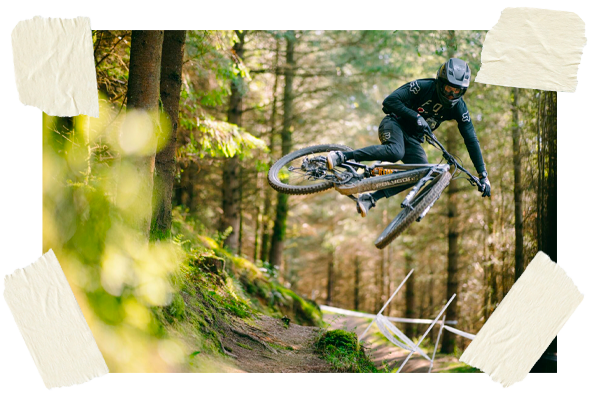
Choosing a mountain bike
Before you hit the trail, you’ll need a bike. A strong and capable bike is the most fundamental ingredient for fun riding. Before you’re ready to buy one, you need to know your way around one.
Choosing a bike can be time-consuming and mountain bikers have a reputation for sweating the small stuff. Follow these basic steps and you’ll find a bike that fits the bill.
Our recommendation
A “Trail” bike is a good starting point for mountain biking in the UK.
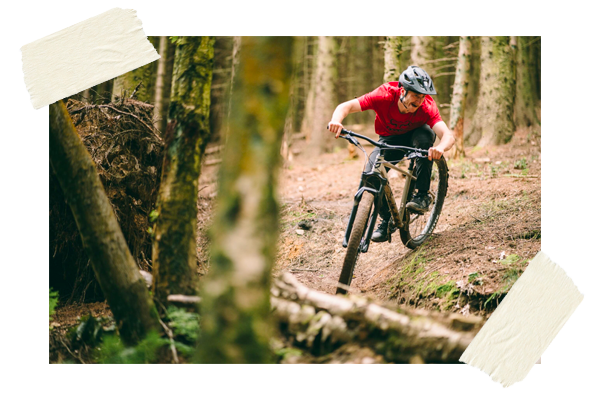
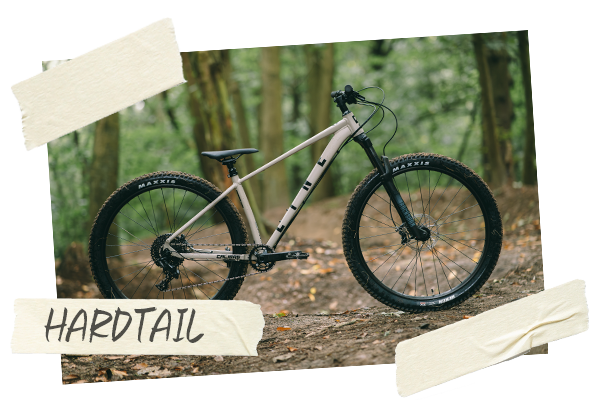
Choose between a hardtail and full suspension
Mountain bikes come with one of two suspension configurations: hardtail and full suspension.
Hardtail bikes are preferred by XC riders because they are lighter and more efficient at turning pedal power into forward momentum. Typically, hardtails are more affordable than full-suspension bikes, so they are a good starting point for any wannabe mountain biker. Hardtails have fewer moving parts, requiring less maintenance – Manufacturers of rear-suspension shocks typically recommend servicing after 60-100 hours of riding.
Full- sus bikes are designed to tackle challenging terrain and can be ridden faster over bumpy ground. Rear suspension also makes the rear of the bike much more supple, so it’s easier to keep your feet on the pedals and land softly from drop-offs and jumps.
Our recommendation: For Cross Country riding and budget conscious beginners, hardtails are an obvious choice. Commuters who want a bike to travel to and from work in the week and thrash trails in the weekend will also appreciate the simplicity and weight saving of a hardtail. Full-Suspension bikes are easier to handle on rough terrain and encourage fast skill progression, they are a clear choice for anybody that wants to ride challenging trails and catch some airtime.

Select a wheel size
Wheel size is akin to religion in mountain biking circles! There are two common wheel diameters, 27.5 and 29 inch. Despite the rhetoric, there isn’t really a wrong choice, just a better one.
The consensus is that bigger wheels roll over rough ground and obstacles with less resistance, making them faster and more confidence inspiring. Smaller 27.5” wheel bikes are more agile and easier to get air bound.
Look out for these components
There are certain components, like a dropper seatpost, that we wouldn’t do without, and you shouldn’t either. Upgrading individual components is expensive so be sure to add these bits and bobs to your Wishlist. In a few months from now you’ll be thanking us.
Hydraulic disc brakes - Rim brakes and cable-action disc brakes will not deliver the stopping power that modern trail riding demands, avoid them unless you simply cannot afford hydraulic brakes or if you’re not interested in riding steep trails.
Dropper post - on UK trails your saddle will be up and down like a yoyo. It’s no fun to move your saddle up and down manually, so make sure your new bike comes with a dropper or add one yourself.
Shimano or SRAM gears with a single chain ring - it’s no longer necessary to get lost deep in gear combos with countless overlapping ratios. Stick to a single chain ring and as many gears on the rear cassette as you can get. Look for “1x10”, “1x11” and “1x12” offerings from Shimano and SRAM, two brands you can trust to deliver dependable, long-lasting performance.
Clutch derailleur - this clever piece of kit keeps a bike’s chain under tension, but still allows rear suspension to function unrestricted. Say goodbye to noisy chain slap and unexpectedly losing your chain. Most derailleurs built by Shimano and SRAM in the last 5 years include this technology.
Air sprung suspension fork - air sprung suspension forks are more supple, lighter, and customisable. Spring-powered suspension still has its uses, particularly on big-hitting downhill bikes, but most of the time an air fork from a reputable brand like RockShox, Fox, Suntour and Marzocchi will provide better trail performance. Just beware that air sprung suspension shocks and forks will have shorter service intervals than coil alternative and are more expensive to begin with.
Tubeless ready - “Tubeless” is running a bike tyre without an innertube. The advantage of losing the innertube is being able to run lower tyre pressures for better grip, without the increased risk of pinch punctures. Because a liquid sealant is used to make the tyre and wheel airtight, small punctures are self-sealing. A “Tubeless ready” bike is one that can be converted to tubeless with minimum effort.
Find a frame size
Choosing a frame size is the final step of picking a bike. Manufacturers use T-shirt style sizing (S, M ,L & XL) to make finding the right size as intuitive as possible. Truthfully, there’s no better way to know if a bike fits you than trying it for size.
Visit a GO Outdoors store to throw your leg over a saddle. If you cannot make it to a store, keep an eye on the REACH and STANDOVER measurements. A longer reach dimension affords space for taller riders to move freely on the bike. Pay attention to standover height too, too much might do you a disservice!
Shop Mountain Bikes here

Basic Mountain Biking Skills
If you can already ride a bike you’re halfway there! To give your first outings on a mountain bike the greatest chance of success, here are five fundamental skills worth practicing.
1) Standing correctly on a bike
Standing on a mountain bike correctly takes practice. Even experienced cyclists who have logged thousands of hours in the saddle get it wrong. It’s the foundation to feeling comfortable on the bike and keeping your centre of balance in the right place.
If you only listen to one pieces of advice from this guide, it’s “keep your heels down and your knees flexed” when descending on a mountain bike. Keeping your heels down will automatically place your weight further back on the bike, ready to counter obstacles that want to stop forward momentum. Keeping your knees flexed will enable your body to absorb shocks and for you to move around on the bike, important for getting grip to the tyres.

2) Looking ahead, not down
Looking at the ground directly in front of your wheel is a cardinal sin. Instead, look 20-30ft ahead, it’s amazing how your brain will adapt to the terrain immediately in front of you automatically.
Not only will you be unable to pick a line through a trail’s features without looking up, but with your head peering over the handlebars and weight forward your centre of balance is shifted dangerously forward. Look ahead, relax and trust your brain and the bike’s suspension to handle the trail beneath you.
3) Braking
Hydraulic brakes stop a bike terrifyingly quickly. If your weight isn’t back behind the saddle, you’ll be ejected over the handlebars like a roman catapult.
Save yourself months in traction by practicing your braking technique before hitting the trail. Before squeezing the brake levers, first drop your heels and move you weight back, behind the saddle. Shifting your weight back will counter the force created by the sudden deceleration of your bike trying to throw you forwards. Remember, when a tyre is being used to slow you down, its friction with the trail surface isn’t being used to control direction. Adjust your speed before entering tight corners and steep terrain so that the bike’s tyres are free to steer you to safety.
4) Railing a turn
Leaning into corners like a Moto GP rider is one of the most common mistakes made by inexperienced mountain bikers. Instead, load the outside pedal with your bodyweight on top of the bike. This applies downwards force to the tyres, keeping them gripping. On bermed corners it’s possible to lean into the turn a little more because the centrifugal force applied by the banking creates grip, but using the right technique on every turn will soon make it second nature.
The other gear you’ll need
The spending isn’t over yet. You’ll need a few more bits and pieces, like a helmet, apparel, and tools, before you’re ready for the trail. If you intend to spend good money on a bike, don’t skimp on the rest of the gear, it’s just as vital to a good time on your bike.
Women specific saddle - The first order of business for any female rider is to swap out your saddle with a female specific gel saddle. Ignore at your own discomfort.
Helmet - The sheer number of helmet options on the market is astounding.
XC riders, like road cyclists, prefer a shallower fitting helmet with good aerodynamics and ventilation. Because of the risk of serious injury from downhill mountain biking, wearing a full-face helmet that offers the highest level of protection to your head, jaw and face is a no-brainer.
For trail riding the best choice is an open-face trail helmet with extended coverage at the back and sides of the head. Trail helmets provide good ventilation at slow speeds for long, unrelenting climbs.
Brands such as Met, Bell and Giro now cater for Enduro riders with full-face helmets that feature chin/jaw protection which can be removed for the uphill sections.
Use our size guide for help getting the right fit.
Shop Helmets here
Body Armour - Although it’s not used universally, we recommend wearing body armour when mountain biking. Lightweight, non-restrictive knee and elbow pads are a must for riding trails - Even the most skilful riders take a tumble now and again.
Shop Body Armor here
Footwear - A dedicated trail shoe designed for flat pedals is what you’re after. Five Ten, by adidas, is the market leading brand for flat pedal shoes. The shoes have a shock absorbent EVA midsole, a wide and stiff sole, and a protective toe box. Five Ten’s Stealth Rubber sole compound offers unrivalled grip on pedals.
Shop Cycling Shoes here
Loose shorts and jersey - The look in Mountain Biking is tailored or loose-fitting clothing that accommodates body armour and the Christmas waistline. Aerated jersey fabrics keep cooling air flowing over your skin. Any mountain bike short worth its salt will include a padded liner, also known as a Chamois.
Shop Cycling Jerseys here
Winter layers - In winter, trail pants with a tapered leg, so you don’t catch them in the chain, are a must. A good pant will have a reinforced seat and room for knee pads. Look for easy to clean and abrasion resistant fabrics (like Polyamide), good ventilation, and zip-close pockets. A lightweight and breathable shell jacket with a pull tight hem and adjustable cuffs is also highly recommended. Ensure it will pack down to fit into your pack.
Shop Cycling Jackets here
Gloves - Your hands are your primary connection with the bike. Gloves not only protect your hands from scrapes and calluses, but they are also vital for grip - Grip on the handlebars and grip on brake levers.
Shop Cycling Gloves here
Trail glasses - Lightweight and flexible trail glasses keep dirt, branches, bugs and wind out of your eyes. Avoid dark tints so they work in a variety of scenarios, like shaded forests. Look for a wrap-around design with good ventilation, as this will offer good peripheral vision and prevent misting.
First aid kit - Now you’re a mountain biker you will invariably be involved in or witness an accident or two. Be prepared with a well-stocked First Aid Kit for cleaning and covering wounds and bandaging sprained joints. If you’re regularly riding in woodland, then be sure to carry a tick removal tool too.
Shop First Aid Kits here
Tools and Sundries- By carrying a small selection of carefully chosen tools you’ll be prepared for fixing most problems. We advise carrying a shock pump... if only to check your suspension set-up before a ride. A bike multitool with allen keys, hex keys, and a Phillips head screwdriver are extremely useful for adjusting loose headsets and suspension linkages. Pack some Duct Tape and zip ties too, you never know when they’ll come in useful, but they always do. A small bottle of chain lube and bike grease completes this shopping list.
Shop Bike Tools & Sundries here
Inner tubes, tyre Levers and a pump- If you’re running tyres with innertubes then a couple of spare innertubes, a pump and tyre levers are essential. Tubeless tyres are self-sealing and therefore don’t require repairing for smaller punctures. In case something big comes along and puts a gaping hole in your tyre it’s best to carry a tubeless tyre plug kit and sealant.
Shop Bike Tyres & Inner Tubes here
A snack and hydration - Low energy and dehydration are your biggest enemies on a ride. Pack high calorie snacks and plenty of water on long rides. A hydration pack/bladder is a comfortable and safe way to carry lots of water.
Shop Energy Snacks here
Backpack - A backpack performs three jobs: It’s a water holder, back protection, and a bag to hold all the bits and pieces you need for a day on the trails. Unless you are bike packing, it’s a good idea to keep the back lightweight and slimline. Between 10 and 20 litres is an ideal volume. An integrated water reservoir with a drinking hose makes carrying plenty of water easy.
Shop Cycling Backpacks here
Bike Preparations & Fixing a Puncture
Before heading out for a day of riding, perform these checks to guarantee your bike is in top working condition. A bike in great working order will perform its best and is less likely to break mid-ride. Your maintenance routine should include:
Check tyre pressure - There’s no magic number for tyre pressure. Most tyres are designed for pressure between 20 and 40 PSI. Less tyre pressure means a larger contact area with the trail and better grip. More pressure means less rolling resistance and less chance of rim damage or pinch punctures from heavy landings. Most people will run a little less pressure in the front tyre and a little more in the rear tyre.
A well-maintained drivetrain runs smoothly- Before setting off on a ride an extra squirt of oil (and removal of any excess) will help your bike to run like a well-oiled machine.
Check suspension sag- Set sag to 25% rear travel and 20% fork travel. Sit on the bike, steady yourself, and dismount without compressing the suspension. Measure from the stanchion lip to the O-ring. Adjust pressure with a shock pump, within max limits, and fine-tune rebound as needed.
Rear suspension - To perform to their best and to prevent the bushings and bearings getting damaged, the linkages need to be firmly connected. Check the bolts between every ride using an allen key. Just don’t overtighten them!
Check your bars and headset- When your headset and bars are loose the results aren’t usually pretty. Use an allen key to make sure the bolts on your stem and headset are tight. Overtightening bolts is almost as bad as leaving them loose, so, make sure they are tightened to the manufacturer’s specified torque rating (usually detailed on the component) using a torque wrench.
Fixing a Puncture- If you’ve never learnt to change an innertube now is the time to learn! The following tutorial will take you through everything you need to know to be able to change flat.
Give it a good clean- There’s nothing sadder than an unloved bike. After a good ride, reward your faithful stallion with a little TLC. A thorough clean with products formulated so not to damage the bikes components are well worth the cost. Towel the bike down before putting it back into storage. If using a pressure washer do not spray the bottom bracket or suspension linkages at close range.
Shop Cycling Parts & Maintenance here
Where to ride
In the last 20 years, with help from government organisations like Forestry England and the back-breaking work of hundreds of volunteer trail builders, the UK has become a world-renowned destination for mountain biking. Up and down the country our hills are chock-a-block with incredible trail riding and downhill mountain bike facilities. Discover a handful of the UK’s best mountain biking locations below or click the link to read our whistlestop tour of UK Mountain Biking.
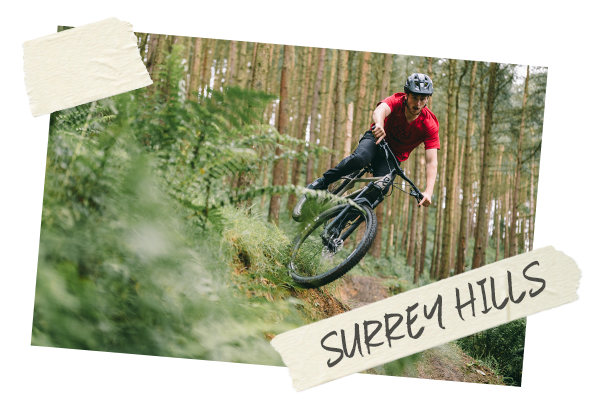
Surrey Hills, Surrey
Beneath the leafy canopy of the Surrey Hills (AONB) is a hidden network of mountain bike trails that stretches from Rowley in the west to Holmwood in the east. Making the most of the North Downs’ elevation, this singletrack heaven has become London’s premier mountain biking destination. The trails are centred around the charming village of Peaslake and are within striking distance of Guildford. Most of the trails are graded green and blue, but there are short stretches of black graded trails, including “Deathstar” and “Crackpipe”. This is not a trail centre, so visitors need to use local amenities. Find out more here
Forest of Dean, Gloucestershire
The Forest of Dean is one of, if not the best place to mountain bike in England. Visitors will find almost 50km of trails for all abilities and 14 dedicated downhill lines graded from blue to double diamond black, for the lunatics. It is all cared for by the good people at Forestry England. Investment into the centre is ongoing and the recently added Adit loop, part of the “Freeminers Trail”, blends the best of natural and manmade features. In 2021, Mountain Biking UK awarded the “Verderers Trail” the accolade of best blue trail in the UK – the perfect day out for aspiring newcomers to the sport. The FOD is a short drive north from Bristol and daytrip-able from the Midlands. Find out more here
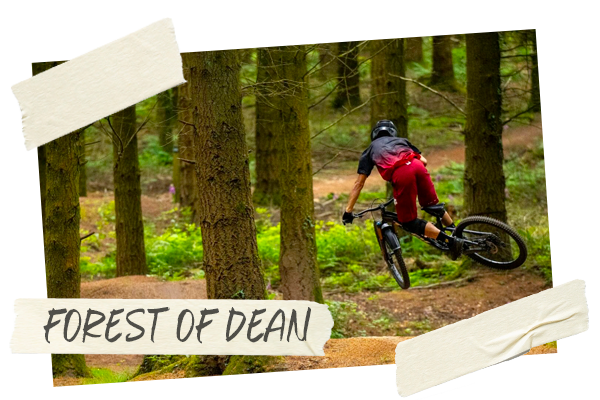
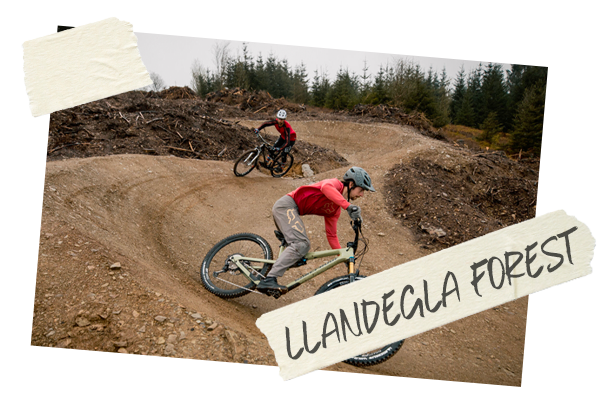
Llandegla Forest, Wales
The Clwydian Range (The Clwyds) and Dee Valley sit along the Welsh boarders. For day-trippers from the Northwest of England’s big cities (Manchester & Liverpool) they’re a short drive. The trail centre at Llandegla Forest is an obvious place to begin exploring the area. The trails range from easy to expert, are well maintained and start from the parking. Recent additions to the black trail network give advanced riders and adrenaline junkies something to smile about: “B-Line” and “Parallel Universe” are epic. The centre’s café is a perfect finishing spot. Beyond the borders of the trail centre the Dee Valley and the Clwyds hide an abundance of trails to be discovered. Find out more here
Fort William, Scotland
The UCI Downhill World Cup has taken place at Fort William since 2002. The event was the spark that ignited Scotland’s obsession with mountain biking. The Lower Forest Trails, which are designed to suit all abilities, weave their way around the base of Ben Nevis. More experienced riders come for the three downhill trails which are accessible by Gondola. Two are graded expert, including the World Cup track, but there’s now a new blue trail for mortals to enjoy too. Find out more here
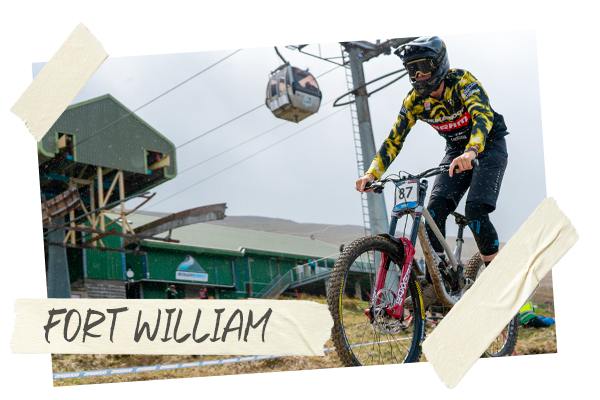
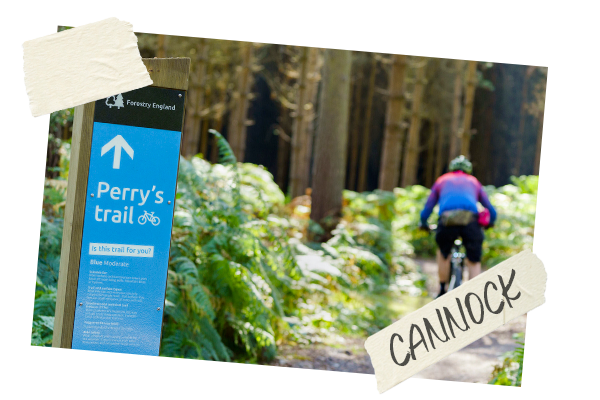
Cannock Chase, Staffordshire
40 minutes north of Birmingham is Cannock Chase. An Area of Outstanding Natural Beauty, the trails here are the result of 34,000 hours of trail digging. Free to ride, the gentle berms and rollers of Perry’s Trail make it a perfect starting point for fledgeling bikers. The 23Km long “Monkey Trail” is fast and flowing, tight and technical, and is a good test of any rider. Next to the cross-country loops is Stile Cop Bike Park. Find out more here
In this guide we’ve covered the different types of mountain biking; the best places around the UK to ride; all the equipment you’ll need; tips for preparing your bike for the trail and some basic riding skills. Right now, there’s almost nothing you don’t know about Mountain Biking. Take that knowledge and get out on the trail.
Glossary of Mountain Biking Jargon
Mountain biking is a minefield of tricky terminology. Here’s a crash-course to the most common terms and phrases that you will come across when comparing different bikes.
All-Mountain - another way of saying “all-rounder”. All-Mountain bikes are designed to be versatile so that one bike can be ridden in different scenarios.
Berm - a banked corner, typically found on man-made trails.
Chainset - this includes the bottom bracket, cranks and chainring.
Dropper Post - an ingenious piece of kit which allows your saddle to be positioned high for pedalling and low and out of the way for descents, at the press of a button.
Group Set - a collective term for all major mechanical components on a bike (brakes and running gear)
Head Angle - this is the angle of the suspension fork relative to the ground. A typical head angle for a modern, short-travel trail bike is ~67 degrees. XC bikes are typically steeper (~69 degrees), which improves traction when climbing, and downhill bikes are slacker (~63 degrees) to improve stability at speed and to absorb impacts on the trail.
MTB - short for “mountain biking”
Rake - also known as “fork offset”, rake is the distance between the axle and a straight line through the head tube. Lots of rake is typical of slack geometry.
Reach - the horizontal distance between the bottom bracket (the bearing where the cranks attach to the chain ring) and the centre of the handlebars. It is an indicator of how the bike fits you.
Running Gear - known as the “drivetrain”, these are the components responsible for propelling a bike forwards, including: Cranks, gear cassette, chainring, derailleur, chain.
Singletrack - a narrow, foot-wide trail that’s ideal for biking.
Standover - this measurement indicates the height of the top tube just forward of the saddle. A low standover height is desirable for self-preservation reasons.
ENJOY THE RIDE!